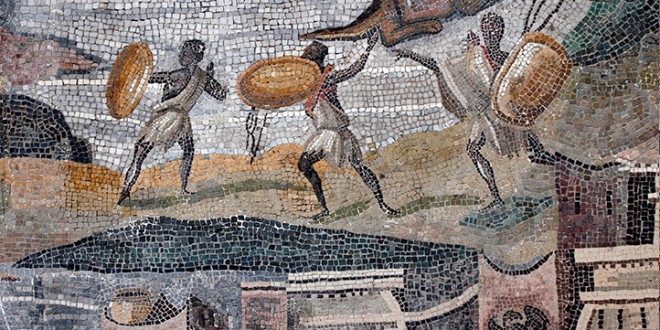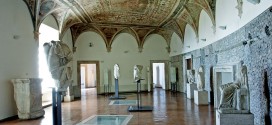The absidal hall, at the Forum square of the ancient city, housed the great colored mosaic representing the scene of the Nile’s flood. It is a very refined floor, built on site by egyptian craftsmen from Alexandria in the 2nd century BC, whose scene is likely to be a copy of a large painting exhibited in the famous library of the city of Alexandria. It is a kind of large map, with South at the top – as used amonge the ancient Mediterranean civilisations – where you can follow the flood of the River, from its sources in the mountains of the Moon, inhabited by Pygmies, down to the mouth/estuary near the city of Alexandria. Just a few places represented on the mosaic are recognizable with safety: the sources (in the upper part of mosaic), the nilometro (to measure the full pit) at Elephantine Island on the left, and in the bottom right corner – the port of Alexandria.
In ancient Egypt flood stage of the river Nile was the time of celebration during which, being unable to work the land while it was fertilized by the waters of the River, the population was hunting, fishing and having feast. The annual flooding was considered as matrimony between the Nile and the land of Egypt, that, according to Plutarch, are represented symbolically by the divinity of Osiris and Isis, from whose matrimony was born Horus – personification of the new crop.
Even the African fauna that populates the landscape is represented with vivacity and imagination.
Each animal, real or fantastic, is accompanied by a caption that indicates the name in Greek, which had become the official language of the Egyptian Court after the conquest of Alexander the Great.
On the map are visible the african rhino, giraffes, giant snakes, several species of monkeys and, in the upper right corner, the mysterious “oneirocentauro“, which probably represents a gnu. Those are both real and fantastic beasts, whose figures, probably derived from treaties of Zoology or Beastiary, constitute the oldest known representation of African animals in Europe and demonstrate how the culture of that time imagined this distant land by giving it the fary tale and imaginary characters. The tiles that compose the mosaic are measuring at least from 1 mm up to a maximum of 8 x 8 mm, and are made of limestone in 8 basic colors with various shades.
This beautiful “carpet”, mentioned for the first time around 1640, was pulled out, divided/splited and brought to Rome. After the splitting of the mosaic, one piece, illustrating a banquet under a Pergola, was acquired by the Grand Duke of Tuscany which he donated to the sister of Frederick II of Prussia, who brought it in the Bayreuth Palace and from there, after short transfer to Potsdam, was exhibited at the new Museum of Antiquities at Berlin, where it still resides.
The section visible today in Palestrina is a copy of the Panel now already “german”. Subsequently the great mosaic was again transferred to Palestrina, in Palazzo Barberini, where specially for that occassion one entire Hall was modified to accommodate mosaic, but during this operation was badly damaged, and with the restoration, beside total makeover, some sections were incorrectly recomposed and that fact modified the original location of some parts. It was again separated during the last war to protect it from the risks of the bombing, subsequently restored and finally placed in the current arrangement.
Fortunately, before 16th century restorations, some mosaic drawings were made (Dal Pozzo collection now at Windsor Castle) to alow us to understand the appearance of the original composition.
 Archeopalestrina Percorso archeologico di Palestrina, l'antica Praeneste
Archeopalestrina Percorso archeologico di Palestrina, l'antica Praeneste

